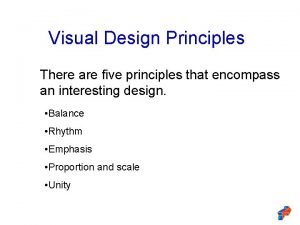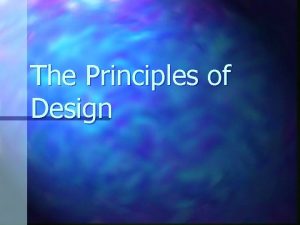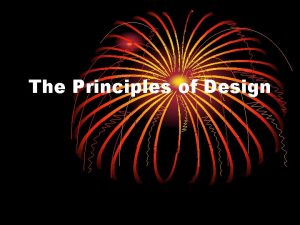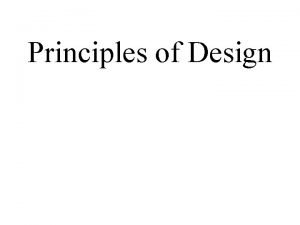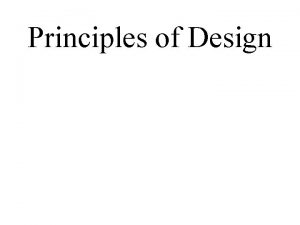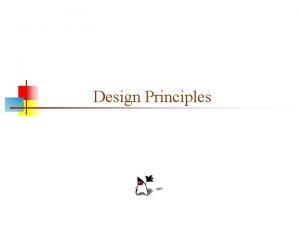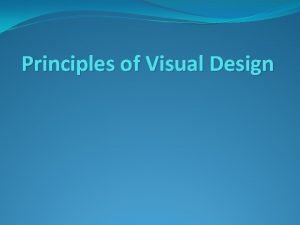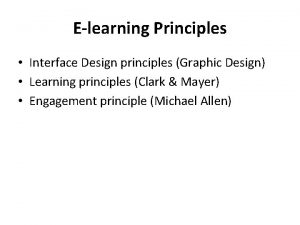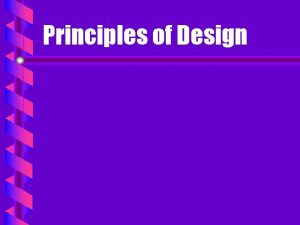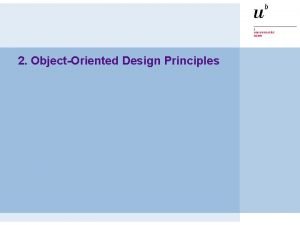Principles of Design Part II What are PRINCIPLES














- Slides: 14

Principles of Design

Part II. What are PRINCIPLES OF ART? *What does using EMPHASIS enable the artist to do? *What is PATTERN / REPETITION and what two ways do artists use it in their artworks? *What are three basic kinds of BALANCE? *What is CONTRAST and how do artists use this in their works of art? *What is RHYTHM and how is it similar to Repetition? *Why is PROPORTION in an artwork important? *How is MOVEMENT like a tour guide?

The Principles of Art are basically rules or guidelines that govern the way in which the Art Elements go together. These include: *EMPHASIS *PATTERN *BALANCE *CONTRAST *REPETITION *RHYTHM *PROPORTION *MOVEMENT Lets take a look at these individually…………….

EMPHASIS is used by an artist to make an element or object stand out in a work of art. EMPHASIS is used by the artist to control What part of the artwork the viewer sees most or most often. EMPHASIS is also used by the artist to control how long a viewer spends looking at each of the different parts.

Emphasis: To make an element or object in a work of art stand Out…. . artists use emphasis. Emphasi s = Emphasis of size Van Gogh Emphasis = Emphasis of color Salvador Dali Emphasis of line Grant Wood

Pattern / Repetition is the repeating of shapes, lines, color, or other art elements in planned or random order to create interest or make the artwork more exciting. Vincent van Gogh Mary Cassatt Andy Warhol

BALANCE in an artwork, it the arrangement of art elements so that no one part of a work overpowers, or seems heavier than, any other part. There are three basic types of balance. These are: *Symmetrical or Formal Balance *Asymmetrical or Informal Balance *Radial Balance

Symmetrical or Formal Balance is created when one half of a work of art mirrors the other half. . Symmetrical or Formal Balance is predictable, thus, sometimes less interesting. Leonardo da Vinci Claude Monet Georgia O’Keeffe

Asymmetrical or Informal Balance is evident when two unlike objects appear to have equal weight. When used skillfully, it can create more interesting compositions. Vincent van Gogh Mary Cassatt

Radial Balance in an artwork occurs when the elements or objects are positioned around a central point.

CONTRAST in an artwork is created-when the artist makes a difference in value, color, texture, shape, line, form, or space. Color Contrast by Monet Value Contrast by Durer Texture Contrast by OKeeffe

Contrast : Form Contrast by Marat Line Contrast By Van Gogh Space Contrast by Monet

In art, PROPORTION is how parts of a work relate to each other and to the whole. Grant Wood Mary Cassatt

MOVEMENT in a work of art directs the viewer through the art piece –often to the focal area. It also encourages the viewer to sense action within the work. Van Gogh
 Mikael ferm
Mikael ferm Principles of interior design ppt
Principles of interior design ppt Part part whole addition
Part part whole addition Unit ratio definition
Unit ratio definition Brainpop ratios
Brainpop ratios Technical description
Technical description Example of footed ware
Example of footed ware The phase of the moon you see depends on ______.
The phase of the moon you see depends on ______. 미니탭 gage r&r 해석
미니탭 gage r&r 해석 Catia exercise
Catia exercise Catia assembly exercises
Catia assembly exercises Graduated rhythm in design
Graduated rhythm in design Basic principle of input design
Basic principle of input design 11 principles of design
11 principles of design Rules that govern how artists organize the elements of art
Rules that govern how artists organize the elements of art











